From the June 2022 issue of Apollo. Preview and subscribe here.
Katrin Bellinger has spent decades ‘looking over the artist’s shoulder’. In the gilt-framed master drawings and 19th-century oil sketches that line the walls of her London home, it is possible to look over the shoulders of hundreds of artists at work, into their studios, observing their practice. Move to the chic, minimalist print room of the mews house nearby, where photographs as well as prints are meticulously catalogued and preserved, and the number of shoulders swells to over a thousand. This rich, ever evolving and expanding collection – grown to embrace work from the 15th century to the very recent – emerged from a fascination with the very act and process of creation. As for the contrasting spaces that house it, they well reflect the public and private persona of this cool – at least on the surface – and unfailingly elegant German, her discerning eye and magpie tendencies; her seriousness of purpose and her sense of fun.
‘I think I was first attracted to the subject by trying to be an artist myself,’ Bellinger says. ‘I went to art school in New York to study illustration and graphic design, and would go next door to the Morgan Library to copy drawings. I asked myself, “How do artists do this?” I quickly realised my limited talent but, in the process, I discovered Master drawings.’ Perhaps comforting is the evidence of the difficulties of making art surrounding us here – images of intense concentration, frustration or despair, periods of ennui or idleness in the studio, as well as the potential hazards of working en plein air (the Barbizon school painter Henri-Joseph Harpignies depicts a fellow artist sketching from the vantage point of a tree). Indeed, we sit talking below a very grumpy, white-bearded Claude Monet standing before an alarming expanse of empty canvas – a rare if not unique painting, almost a caricature, by the actor and playwright Sacha Guitry, who had filmed the artist painting in his garden in Giverny in 1915.
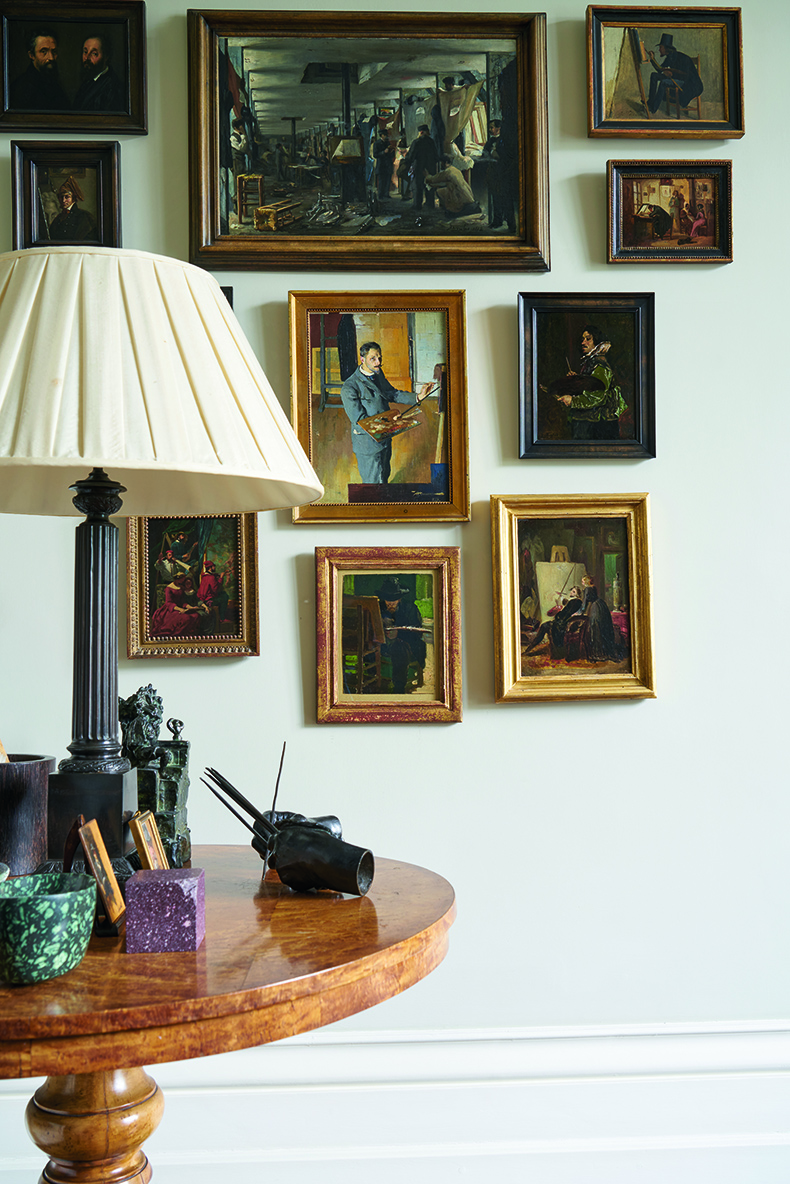
Hands of the Painter Meissonier (1897), cast in bronze by Vincenzo Gemito on a side table. On the wall are several 19th-century oil sketches including (top right) L’Aquafortiste (the etcher) by Honoré Daumier. Photo: Julian Anderson
Art school was exchanged for the Sotheby’s Works of Art course, and it was while she was on that course in London that she acquired her first Old Master drawing. Then another, and another. ‘I think collecting is something you are either afflicted with or not,’ she says with a laugh. ‘Even as a child I could not come back from a walk without collecting pebbles, then it was biscuit tins. I always say that anything I have more than three of could potentially become a collection.’ As for the drawings, she felt that she could not just keep on buying more and more, which is why at the age of 28 she decided to become a dealer, ‘not really having a clue how to do it’. She was fortunate in being in the right place at the right time: Munich in the early 1980s. ‘I was lucky because I met a couple of wonderful collectors in Munich who became my mentors – Wolfgang Ratjen and Hinrich Sieveking. They were delighted that someone young was entering the market and were incredibly helpful. They found me material, put me in touch with other collectors and would proofread my catalogues. I would buy drawings in Germany and sell them in London.’ This was around the time of the first sale of Old Master drawings from Chatsworth, when the drawings market began to take off, thanks in no small part to the acquisitiveness of the J. Paul Getty Museum. ‘There were other young dealers starting up in Germany too, such as Thomas Le Claire in Hamburg. Everyone was so collegial. In the drawings market, even though you are competitors, you are also friends as you all share the passion for drawings.’ After she had been a private dealer for 15 years, her old friend Konrad Bernheimer bought the venerable firm of Colnaghi in London’s Bond Street. ‘Given its huge reputation for drawings, he asked me if I would like to join him.’ They were business partners for 13 years until Bellinger decided it was time to stop dealing – though not buying – in 2015.
Early on in her career Bellinger convinced herself that it would be a shame not to keep anything at all. The first work she chose to set aside determined the course of her collection: a small self-portrait in pen and brown ink by Pier Leone Ghezzi (1674–1755) of the young artist drawing a portrait bust in his studio: ‘I have always been intrigued by how artists chose to represent themselves.’ Such a drawing was not expensive at the time, nor were the countless examples by little-known or anonymous artists that she amassed with equal enthusiasm. ‘Of course, there is a conflict of interest if you collect what you deal in, so it was helpful to have a theme that my colleagues and collectors knew about.’ Even so, she would have loved to have acquired Twenty Drawings Depicting the Early Life of Taddeo Zuccaro (c. 1595), made by Federico Zuccaro recording his brother’s travails and eventual success as a young artist in Rome, when they came to auction. The Getty asked her to bid on its behalf. ‘That was that.’
While Bellinger’s personal taste is very much for 16th- and 17th-century Italian drawings, it was clear she could not confine her collection to these. A collector can only buy what is available. ‘Finding a great drawing by a great artist of my subject just does not happen very often,’ she points out, not too ruefully, ‘but I have been lucky enough to find fantastic things from the French 18th century – not my favourite period.’ Testimony to this are the walls of the lower level of her sitting room. In pride of place above the chimneypiece is The Inspiration of the Artist, a highly original – and highly personal – tour de force in pen and brown ink and wash by Jean-Honoré Fragonard. Here the tortured artist, hand melodramatically clasped to his forehead as he sits at his table easel, is bathed in the light of inspiration as the angels, putti and other figures forming in – or guiding – his imagination swirl around the edges of the sheet.
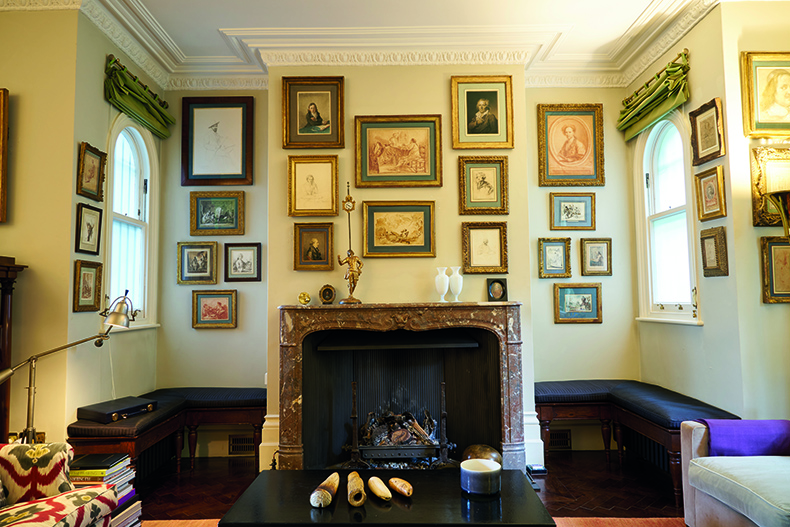
Above the fireplace in the sitting room is The Inspiration of the Artist by Jean-Honoré Fragonard (centre, below). Surrounding it are works by Jacques Lemoine, Hubert Robert, Jean-Jacques Karpff, Jean-Auguste-Dominique Ingres and Marie-Gabrielle Capet. Photo: Julian Anderson
What is wonderful about this wall – and indeed all the walls in Bellinger’s house – is the interconnectedness of the images and the stories they tell. ‘I like works of art to speak to each other,’ she says. Above and to the right of the Fragonard, for instance, is a rare picture of the artist himself, holding a porte-crayon – not a brush – close to his heart, drawn in chalks in 1797 by Jacques Lemoine. Its pendant, across from a Hubert Robert red chalk, is a penetrating and near-contemporaneous pastel self-portrait by the Colmar artist Jean-Jacques Karpff, who trained in Paris under Jacques-Louis David. He, too, holds a porte-crayon above a blank page, his intense, upturned gaze perhaps also suggestive of inspiration. ‘What a drawing!’ Bellinger says enthusiastically, ‘It is very exciting to find a great work by an artist you have never heard of.’ Beneath it, in contrast, hangs a graphite drawing by one of the most celebrated draughtsmen of all time. Here, Jean-Auguste-Dominique Ingres is depicting the engraver Desnoyers sitting at his workbench, burin in hand.
David’s rival, the history painter François-André Vincent is shown below, drawn in profile in coloured chalks by Marie-Gabrielle Capet, an artist trained by Adélaïde Labille-Guiard. Here, Bellinger changes her tone. ‘This is the moment of Le Brun and the great 18th-century French women artists, and Labille-Guiard was one of them. She takes Capet in like an adopted daughter.’ Capet stayed even after Labille-Guiard married Vincent, and remained in the family home after her teacher’s death. ‘She does this very touching portrait of him. He is already quite frail, and looks a bit pale, but what a wonderful portrait – and look at the shimmering satin.’ She continued: ‘Finding historic works by a woman artist is not easy. This may not be a portrait of an artist at work, but it is a portrait of an artist. I was thrilled to find it.’
Bellinger has always sought out depictions of women artists. ‘Most of them are amateurs because drawing was considered an accomplishment, like playing the piano, but God forbid that you do them too well. Images of women painting is a different story. Oil paint is messy. If you see a woman painting, the likelihood is that she is a professional.’ A cluster of drawings and paintings by François Bonvin in Bellinger’s study includes a signed black chalk drawing of his mistress’s sister, Sophie Unternährer, at the easel. Fortuitously, the painting he made from it in 1848 subsequently also turned up on the market, as did the painting from his early drawing of a schoolboy in his smock drawing on a pad on his knees. There have been comparable felicities, such as a painting of students in a life class where a drawing of the very artist’s model evidently made at the same time has also been found. At times, the male gaze is problematic. ‘I find it uncomfortable that these two butch men are looking at and sketching the model with the top of the easel like a phallic symbol at her side,’ she says of Maxime Dethomas’s charcoal Model in the Studio.
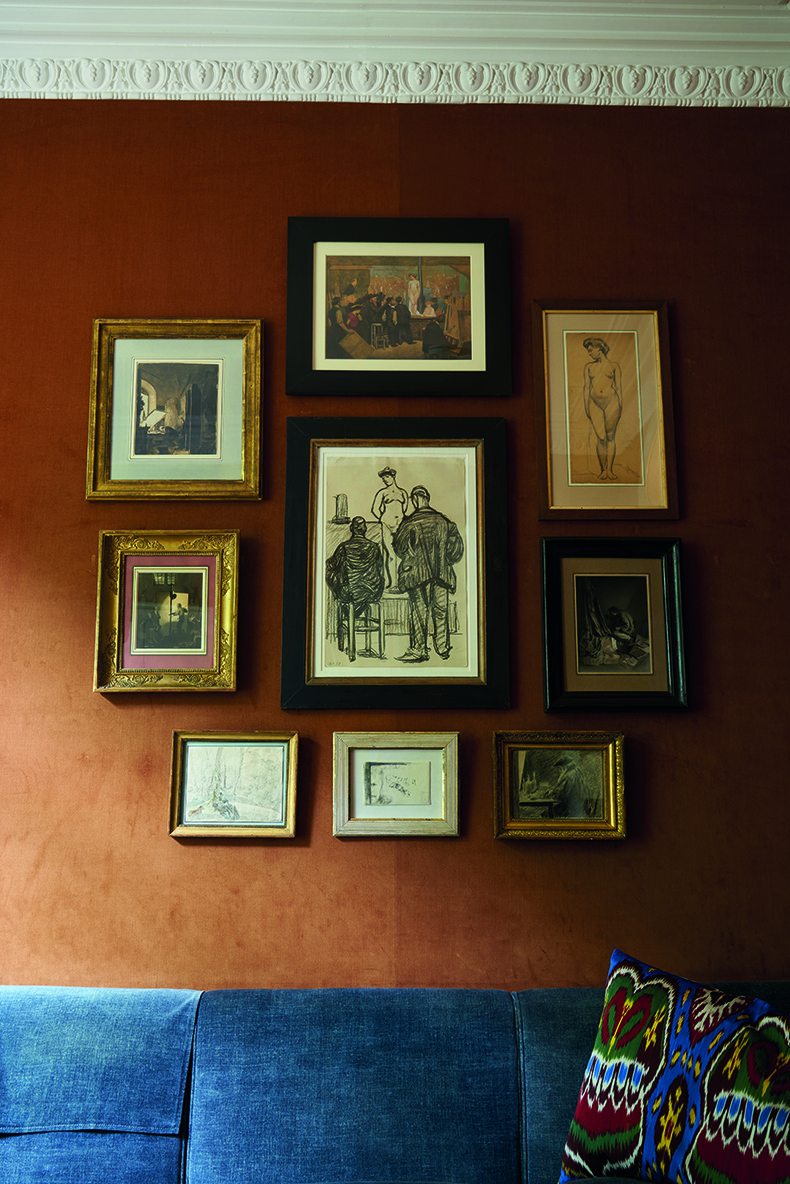
In the centre of this wall in the study is Model in the Studio (n.d.) by Maxime-Pierre Jules Desthomas. Photo: Julian Anderson
The collection began with drawings of artists and their materials. ‘The logical next step was prints, and printmakers, as drawings often relate to prints. Then I moved on to 19th-century oil sketches.’ Striking here is the eager, fresh face of an early self-portrait by Daniel Maclise – ‘The first model for an artist is always themselves; when older, the self-portrait is often about status. They all beg the question of what image the artist wants to project.’ The Liverpool painter William Daniels curiously chose to depict himself as An Italian Image Seller (1870), an itinerant purveyor of reduced-scale plaster casts of antiquities, personifications of virtues and famous men, with Shakespeare on the board carried on his head and Homer cradled in his arm. It is perhaps less a commentary on the lot of a jobbing artist than a personal iconography of his interests and character.
‘The risk of a thematic collection,’ Bellinger explains, ‘is that it becomes repetitive, so any new acquisition really has to add something to the collection.’ Her solution to the problem is continually to break new ground. Next, she turned to photography, her pretext being that her husband, Christoph Henkel, liked it. ‘There are wonderful portraits of, say, Louise Bourgeois in her studio. As I am never going to be able to afford a work by her, this was a way of bringing the artist into the collection in another medium.’ She particularly relishes vintage photographs of the studios of the artists in the collection.
Then came sculpture and sculptors. Side tables boast groups of everything from portrait reliefs and medals to a rare early South German artist’s lay figure or mannequin of around 1550 and the Hands of the Painter Meissonnier, brushes and palette in hand, cast in bronze in 1879 by Vincenzo Gemito. In fact, images of artists’ hands and their tools and materials are among the most intimate and eloquent of the collection. Not least among them are Egon Schiele’s spare crayon drawing of his box of pens and pencils left on the floor in Office at the Mühling Prisoner of War Camp (1916) and Adolph von Menzel’s bravura studies of a man painting of 1888, his total absorption, like the pressure of his subject’s brush, almost palpable.
The eagle-eyed visitor to Bellinger’s home will spot the brush pots, brushes, ink sticks and scholar’s rocks found on the Chinese scholar’s desk – a nod to the time Bellinger began learning Mandarin. There is also evidence of myriad other natural history objects that Bellinger finds ‘irresistible’. ‘They are,’ she says, ‘another thing that I try to kid myself that Christoph is interested in.’ To be fair, he is. After buying a narwhal horn – these twisted ‘tusks’ of a small Arctic whale were once believed to be the horns of unicorns – she was compelled to commission a monumental drawing of it from Jonathan Delafield Cook, complete with whale attached.
In the past few years, Bellinger has been further diversifying the collection by moving into contemporary art. Serving as the National Gallery’s liaison trustee with Tate has accelerated the impetus. Excited by its possibilities, her eye has alighted on works ranging from Michael Craig-Martin’s digital print of brushes, Savarin Can of 2018, and Phyllida Barlow’s bronze Untitled (Paintsticks) (2017) to Lisa Brice’s inky blue oil on trace of a woman artist, palette in hand, and one of the Swiss artist Not Vital’s disembodied self-portrait heads, which finds a place on a mantelpiece. ‘The wonderful Katy Hessel is helping me to identify young artists’, she enthuses. ‘My son Paul, who is opening a gallery in New York, encouraged me to commission Yinka Shonibare.’ Responding to the collection, Shonibare made Planets in My Head: Young Artist II (2021), the life-size mannequin sitting at her easel dressed in his trademark batik textiles. ‘I had wanted it to show an artist drawing, but it did not work out, so he attached a Victorian pencil to the bottom of her canvas.’
‘The advantage of having this kind of themed collection is that you can always find an inexpensive photograph or a little print,’ she admits. ‘I am not the most disciplined collector. I would always tell my clients that it is better to buy one thing a year than buy a lot, but I could never adhere to that at all. I smuggle in new pieces all the time, but it is important to remind yourself that in the end a collection is remembered, and very much defined, by its top pieces.’
For Bellinger, however, her activities as a collector are ‘not all about shopping. I wanted to share the collection, do something with it.’ Sharing it with artists has been particularly fruitful of late. After a visit from Deanna Petherbridge, the draughtsman and author of The Primacy of Drawing (2010), asked if she could curate a show of the collection, realised at The Courtauld Gallery in London in 2018. Previously, the collection provided the core of ‘Drawn from the Antique: Artists & the Classical Ideal’, shown at the Teylers Museum, Haarlem, and Sir John Soane’s Museum, London, in 2015. More recently, Iwona Blazwick and Candy Stobbs went to the mews and, ‘like kids in a sweet shop’, picked out about 25 works for the current ‘A Century of the Artist’s Studio 1920–2020’, at the Whitechapel Gallery, London, until 5 June. Langlands & Bell drew exclusively from Bellinger’s collection to present ‘Absent Artists’ at Charleston, East Sussex, a gathering-point for the radical writers and thinkers of the Bloomsbury Group where Vanessa Bell and Duncan Grant lived and worked. These are images of empty artists’ spaces, like Charleston itself (the show continues until 29 August).
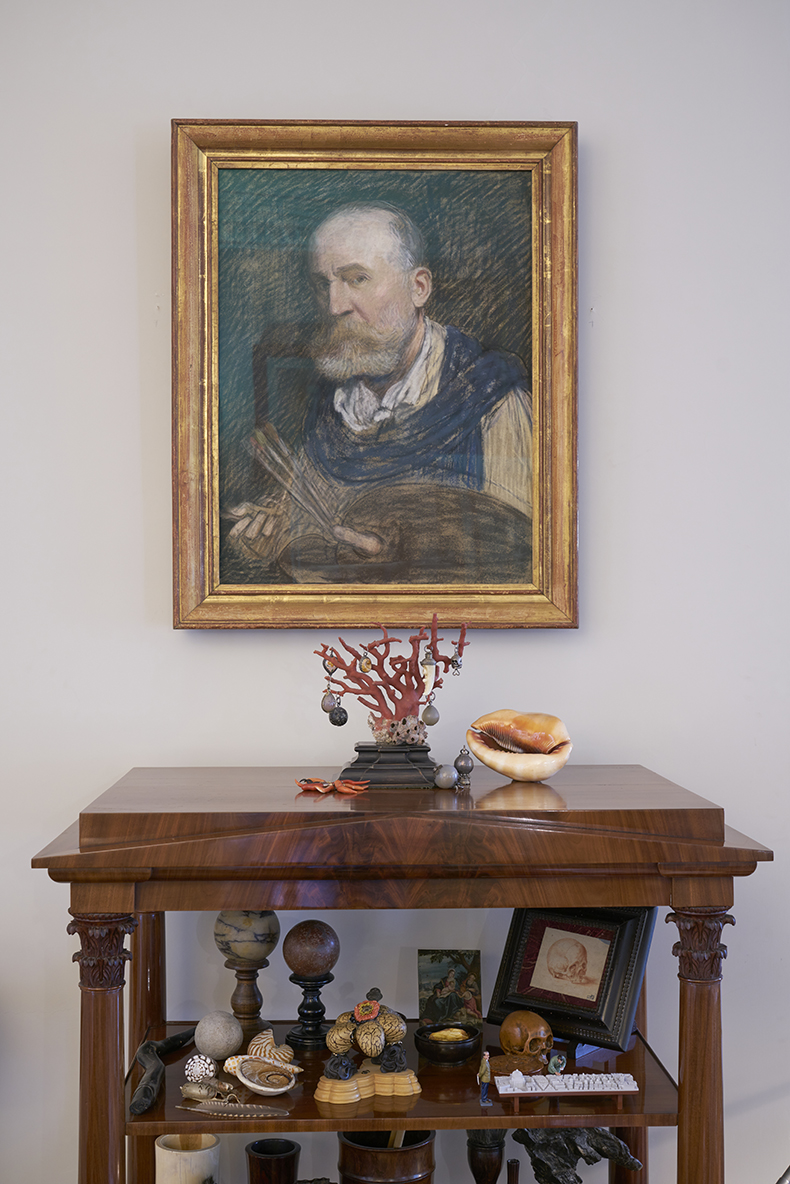
Self-portrait holding a palette (c. 1883–87), Pierre Puvis de Chavannes. Photo: Julian Anderson
Bellinger’s focus on artists at work led to her becoming the founding supporter of the international Artist’s Studio Museum Network, initiated by the Watts Gallery – Artist’s Village in Surrey – the only purpose-built artist’s gallery of its time. Such initiatives and her collection are administrated through her Tavolozza Foundation, which she founded in 2001. ‘As a dealer in a field like drawings, you very much depend on the expertise and knowledge of experts in the field, and in most cases they give their expertise freely. I felt that having done fairly well, I wanted to give back.’ The Foundation supports museums and galleries, publications, study days and symposia that keep works on paper visible.
The print room is another way of sharing the collection. ‘Part of the fun of collecting is the exchange, showing what you have to others who are equally interested and hearing their thoughts. The collector’s favourite game is getting out all the anonymous things and hoping someone might be able to identify them,’ Bellinger says. She is always intrigued by the responses of artists, which are often quite different from those of connoisseurs or art historians. The latter are frequently welcomed here, and no doubt notice that the felt used for lining the cupboard shelves is the same blue that the celebrated 18th-century drawings collector Pierre-Jean Mariette favoured for his mounts. Anita Sganzerla, curator of the Bellinger collection – responsible for research and writing blogs and catalogues – is proactive in organising students’ visits, as well as museum groups. ‘By the end of the sessions, most visitors feel rather overwhelmed,’ Bellinger admits.
Before we part, I ask if there is any particular favourite in the collection. ‘The last acquisition is always the one you like the best,’ she says, alluding to a significant lockdown purchase. It is hard to imagine this portrait of one draughtsman by another not remaining a firm favourite: apart from its subject matter, Louis de Carmontelle’s watercolour and black and red chalk portrait of Vivant Denon portraying the Chevalier de Cossé, of around 1775, survives in unusually vivid condition. This light-sensitive watercolour will not stay long on the wall. ‘If you come here unannounced, you will find every drawing is under its own numbered cover. The whole place looks like a Christo installation. It is mayhem when we rehang,’ she says. ‘You really have to love works on paper to collect them.’
From the June 2022 issue of Apollo. Preview and subscribe here.
Unlimited access from just $16 every 3 months
Subscribe to get unlimited and exclusive access to the top art stories, interviews and exhibition reviews.

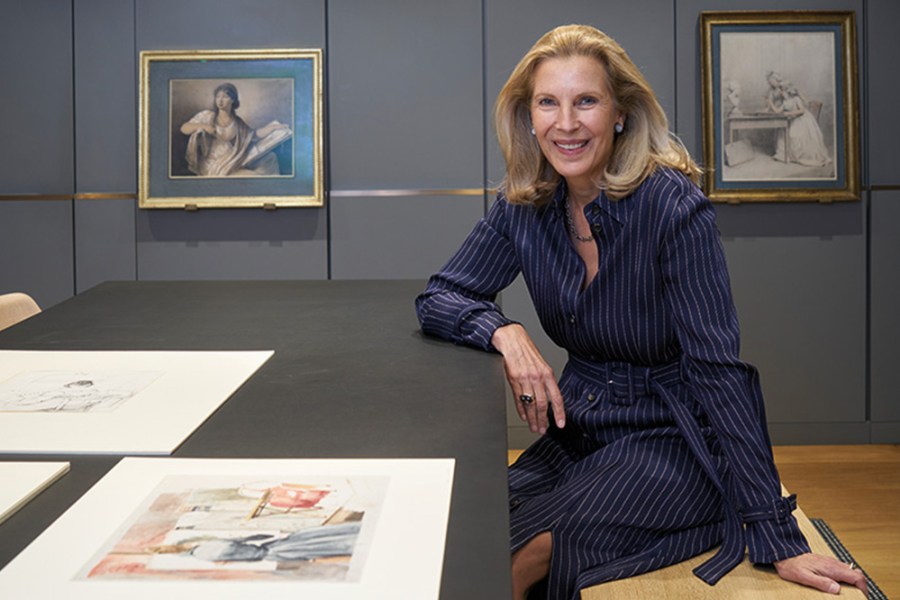
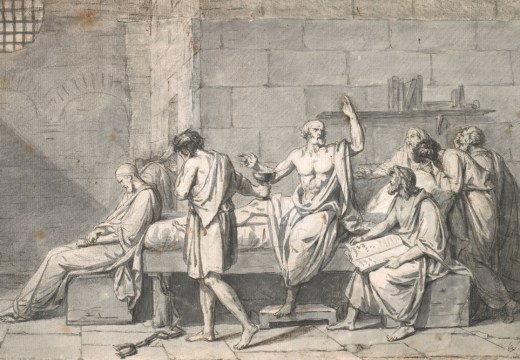
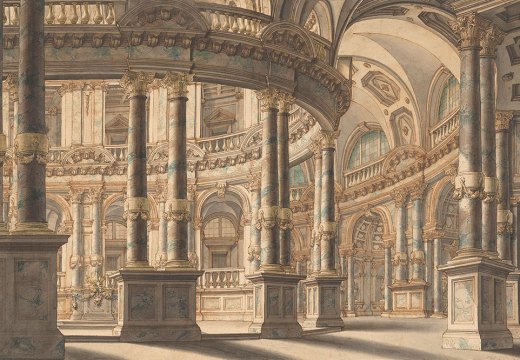
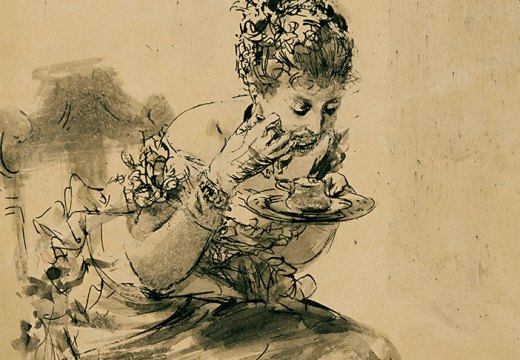









![Masterpiece [Re]discovery 2022. Photo: Ben Fisher Photography, courtesy of Masterpiece London](http://www.apollo-magazine.com/wp-content/uploads/2022/07/MPL2022_4263.jpg)
It’s time for the government of London to return to its rightful home